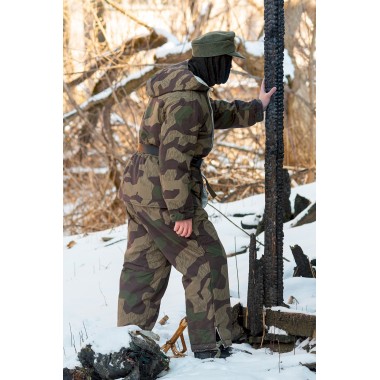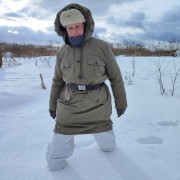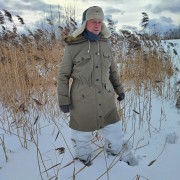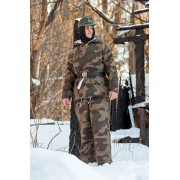How to choose the size?
A new batch of pants will be ready in October 2022.
The price is only for the pants. Suitable jacket is sold separately. See the recommended products at the bottom of the page. Buy pants and jacket at once to get a set. The color and material may change slightly with each new batch, you can't buy a part of the set in addition later, we will not be able to select the matching fabric!
In the product photo: size II (medium) is worn on a person who usually wears Russian size 54 or XL, 2XL. Height 187 cm, chest 105 cm, girth 96 cm. The parka is worn over a thin pullover, without a field jacket.
The size of the jacket fits the size of the pants, that is, the jacket and pants must be bought in the same size. If you wear a tunic of size M, then you need to buy a winter jacket M (that is, size I), you should not add the size "for the winter", everything has already been added. The standart height for the jackets and pants is 182 cm. This affects the length of the sleeves for jackets and the length of the legs for pants. German winter jackets were of three sizes: small, medium and large; we did the same. German winter jackets are made wide enough not to fetter a soldier and to fit different body-shapes; this must be understood if you are not buying a jacket for reenactment, but for civilian use.
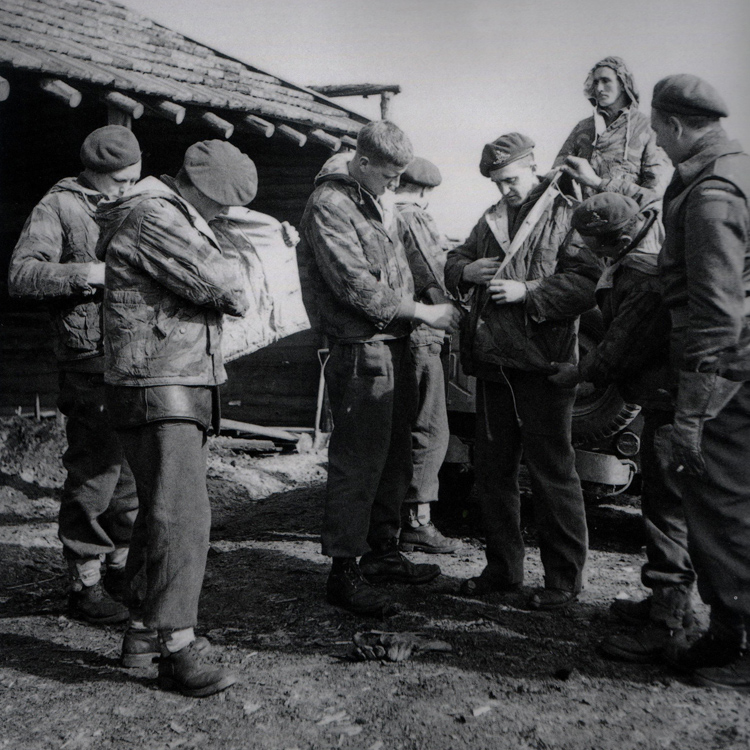
Canadian soldiers in Merksem, Belgium (near Antwerp), seizing the unifroms warehouses of the factory Reitz. The terrain is flat, rugged by rivers, the weather is windy and cold: Canadians are insulated as they can. Pay attention to the ratio of length and width of German winter jackets. Photo source: National Archives of Canada and the book of V. Palinckx "Camouflage uniforms of the German Wehrmacht."
Usually, German winter and camouflage clothing was made in only three sizes: small (I), medium (II) and large (III).
To measure your waist, you will need a flexible meter or at least a rope. You should compare measurements from our size chart with any pants that fit you.
• Suitable clothing size — approximate compliance with general sizes, to start with. Next, you need to check the rest of the measurements! Several sizes of clothing are included in one pants size, since winter uniforms are usually large, and the difference of 1 standard size is not noticeable.
• Max. waist — the girth below the rib, but above the navel, where the Germans worn the waistbelt. The first number is measurement on the naked body (in brackets, it was measured over the shirt + sweater + jacket, as it is customary to wear these pants). The number shows the maximum waist, that is, your measurement should be less than in the table, to 5 or more centimeters. Pants should not sit tight at the waist! There should be a gap at the waist, which, if necessary, is tightened with a lace-tie on the back. If there is no gap, then it will be difficult to bend down in your pants.
• Width of the pants on the upper edge — the pants are lying flat on the floor, you measure along the back half of the pants (it is wider than the front one). You can compare it with any winter pants, but please remember: these pants do not have a waist, they are tightened at the waist with a flap. This measurement is only needed here for reference. The pants will fit almost any large waist, as they have no waistband.
• Pant leg length at the inner seam — the length of the pant leg from the "fork" to the bottom, this is the most important size for determining the height, you need to compare with other pants that you wear. "Burdocks" at the bottom of the pants, which should lie on top of the foot, are not taken into account when measuring the length. We don't have any other height sizes!
• Pants full length — the full length of the pants along the outer seam.
All measurements are in centimeters. Devide numbers to 2,54 to have inches.
| Size of the pants | Suitable clothing size RUS/EUR (INT) | Waist maximum naked (and over the tunic), cm | Width of the pants on the upper edge, cm | Pant leg length at the inner seam, cm | Pants full length on the side seam, cm |
| I | 46-50 (S-L) | 90 (98) | 49 | 72 | 110 |
| II | 52-54 (XL-2XL) | 103 (112) | 56 | 74 | 114 |
| III | 56-60 (3XL-5XL) | 116 (126) | 63 | 77 | 118 |
If you do not understand the table and you need help, write or call us, we will help you to find the size.
You can choose the size from those in the list near "Add to Cart" button. If we don't have any size in stock, you can't choose it. Perhaps it will appear later.
Description
The pants are made of natural fabric with linen weaving (cotton duck, such as a tent). Such fabric protects from wind and water the best. The fabric has an invisible and imperceptible water-repellent impregnation on the white and camouflage side. The rain rolls down from it.
The camouflage pattern is carefully copied: this is the work of of our Replika shop team. The fabric was made exclusively for our Replika shop and used for our winter jackets; it is not sold anywhere except reenact.store. The colors of the camouflage are copied from the autumn side of the original Zeltbahn (German cape-tent). The Zelt was opened at the seam to see the real non-faded colors as they were when the item was new.
Inside the insulation from recycled clothing is used, as it was in the originals. The Germans collected the old uniforms, as well as civilian clothes (including trophy and confiscated) and recycled it, getting a cloth like a loose blanket. The composition of such insulation varied due to the heterogeneity of the raw materials. In general, winter suits were not very warm. They had to be worn over a shirt, a cloth uniform and a sweater (a multilayer military uniform system is used to date). In a full suit, it is comfortable down to -15 degrees Celsius, however, this is not enough for guard duty (long inactivity), for this there were a special overcoat and guard boots.
The pants are made on the early model, that is, without reinforcements on the knees, without a windplap at the front, with metal buttons on pockets. These began to be produced at the end of 1943, in preparation for the winter of 1943/44. And by the following winter, "knee patches" appeared and the metal buttons were replaced with cheaper plastic or cardboard ones.
We were attentive to the details, found and copied even insignificant and inconspicuous at first glance.
The pocket flaps of winter pants were always 4-pointed.
These pants have ink stamps of the manufacturer (company name + city) and size (numbers 1, 2 or 3, respectively).
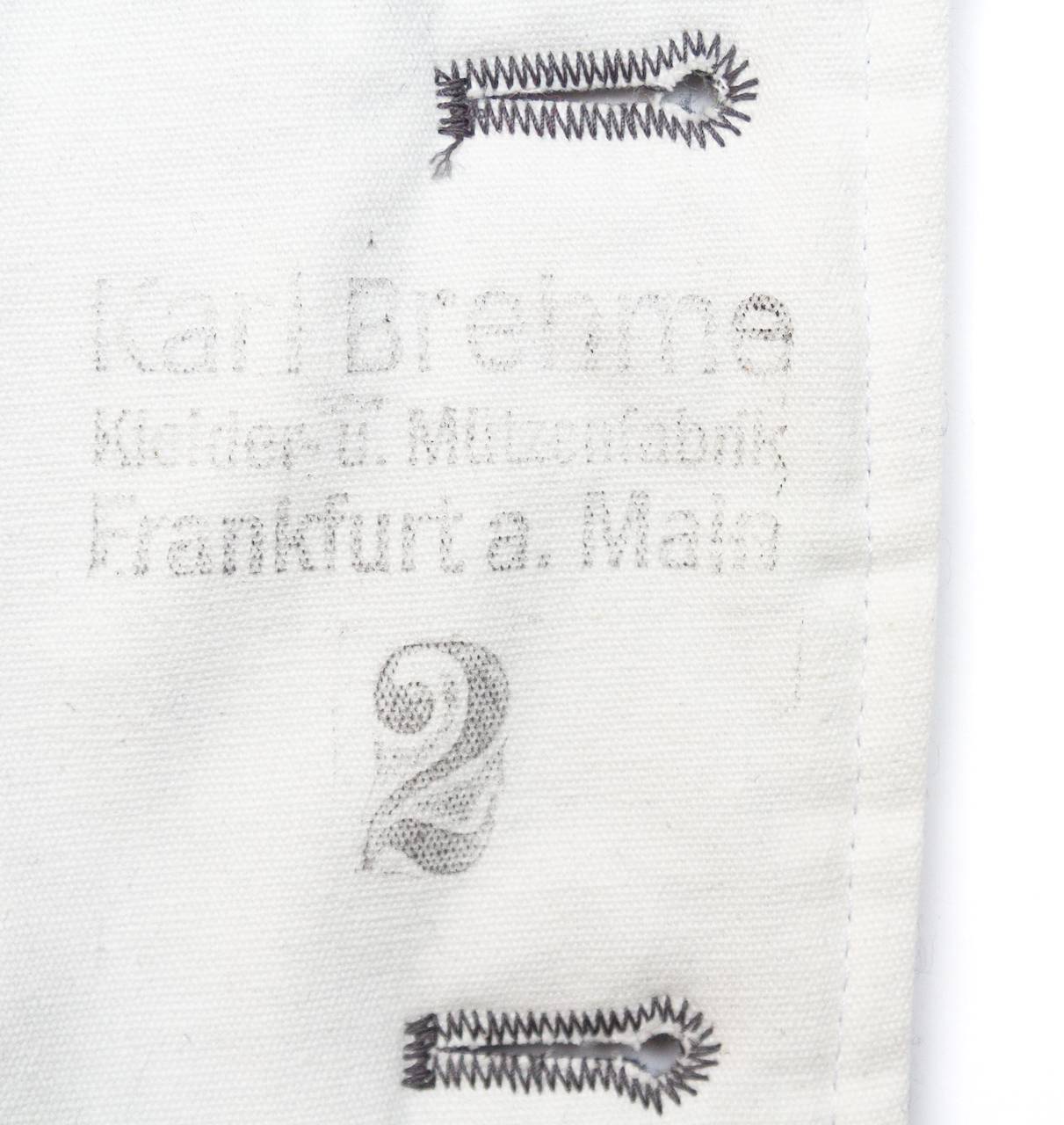
How to care for the product?
The soldiers at the front did not have the opportunity to wash their jackets (especially in the washing machine). After the winter (or in the case of taking the unit to rest in the deep rear), they handed the winter uniform over, and the rear services cleaned, sorted and stored it. Therefore, washing the winter uniform in the washing machine is an extreme measure. To get started, you just need to wash the jacket with a sponge or a soft brush with soap or detergent for natural fabrics in those places where it is dirty (usually this is the neck and cuffs). You can wash off the detergent with a jet of water (shower in the bathroom, for example).
The use of bleach (stain remover) is permissible only manually on the white side and on a dry jacket. So you can return the whiteness to the cuffs and other dirty areas. However, if bleach seeps onto the camouflage side (for example, through a seam), white spots will forever remain. It is unacceptable to wash the entire jacket in bleach!
Washing a jacket is the removal of contaminants from external surfaces; inside the jacket there is nothing to wash. If you decide to save time and wash in a machine, then select the delicate washing mode at a temperature of no higher than 40 degrees. The jacket will not deteriorate, the color will not fade, however, the jacket will slightly lose its shape and will no longer look like new.










